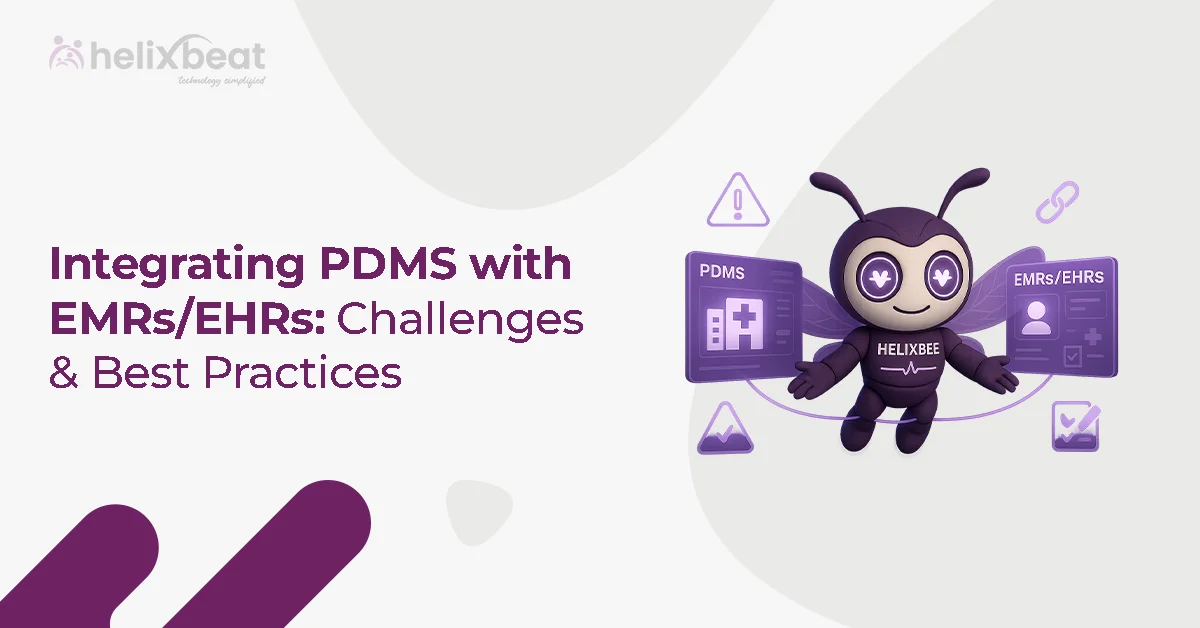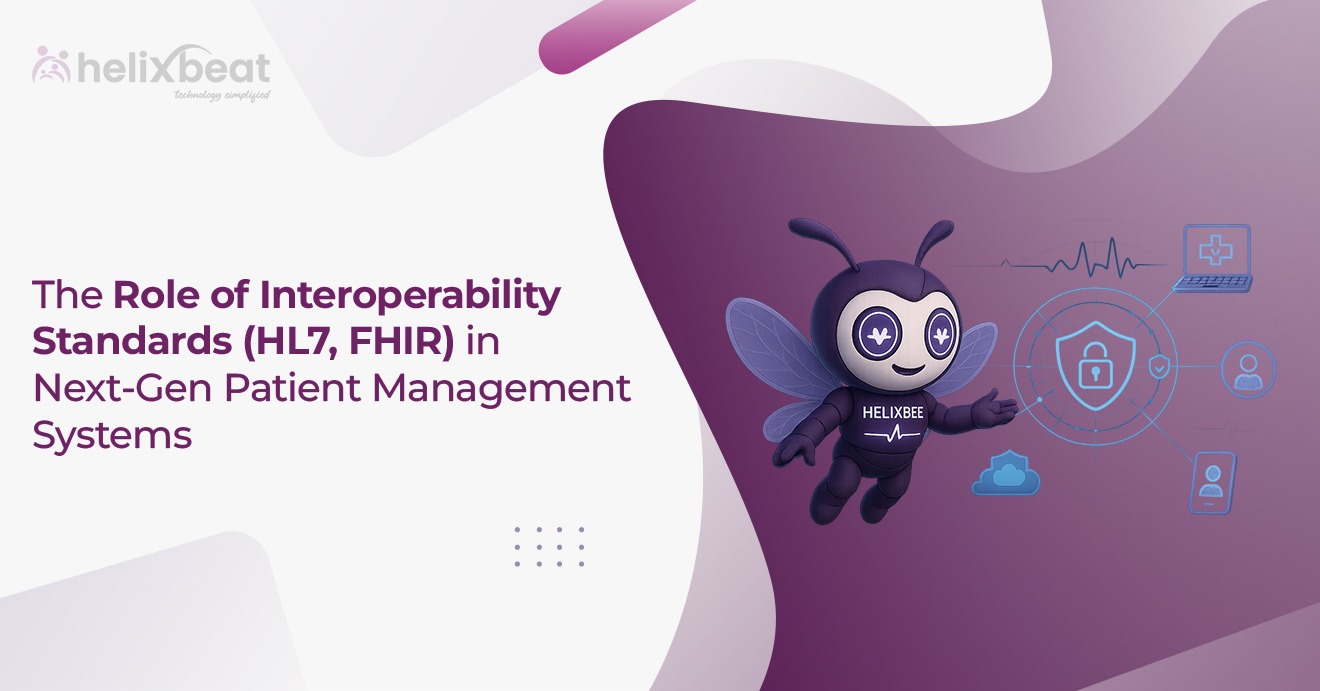Digital transformation in healthcare has become the new normal. No matter how big or small a healthcare organization is—whether it’s a neighborhood clinic or a multi-specialty hospital—embracing technology is essential.
According to a report by Deloitte, over 92% of healthcare executives say they aim to achieve better patient outcomes through digital investments. Another study by McKinsey estimates that digital transformation in healthcare systems reduces costs by up to 20% while improving care quality and accessibility.
Today’s patients expect more—appointment scheduling, telehealth options, remote monitoring, and real-time access to medical records. Technologies like AI, cloud computing, IoT, and data analytics are driving this shift. What was once futuristic is now critical.
This guide walks through Helixbeat’s digital transformation in healthcare organisations through the essential strategies, technologies, and roadmaps to succeed in a digitally-driven future.

Table of Contents
Why is Digital Transformation in healthcare non-negotiable?
The demand for digital healthcare solutions has never been higher. Here’s why the digital transformation in healthcare isn’t just a trend—it’s a critical need for the survival and growth of health organizations.
- Improved Patient Outcomes Digital technologies enable healthcare providers to leverage data more effectively, improving diagnosis, treatment, and follow-up. From predictive analytics to machine learning, real-time data empowers healthcare teams to make more informed decisions, resulting in better care outcomes. By utilizing technologies like AI-powered diagnostics, telemedicine, and patient monitoring systems, healthcare organizations can identify potential health risks earlier, personalize treatment plans, and optimize patient care throughout the entire journey.
- Enhanced Operational Efficiency Streamlining administrative tasks, automating workflows, and reducing manual processes lead to significant operational improvements. By adopting cloud-based management systems, electronic health records (EHRs), and patient engagement tools, healthcare organizations can significantly reduce time spent on paperwork, increase collaboration across departments, and enhance the overall efficiency of the organization. This means quicker appointment scheduling, faster test results, and fewer mistakes in patient care—all of which contribute to a more efficient healthcare environment.
- Improved Patient Experience The patient journey is no longer limited to physical visits to a clinic or hospital. Patients increasingly expect seamless digital experiences, from online appointment booking and virtual consultations to mobile health apps that track their progress and give them direct access to their healthcare providers. Digital transformation in healthcare organizations allows them to meet and exceed these expectations, improving patient satisfaction and fostering loyalty.
- Cost Savings While the initial investment in digital tools and technologies might seem high, the long-term savings are undeniable. By reducing the reliance on paper records, minimizing administrative overhead, and improving workflow efficiency, healthcare organizations can significantly reduce operational costs. Furthermore, automation and AI reduce the risk of errors, leading to fewer costly mistakes.
- Regulatory Compliance and Data Security With healthcare being a highly regulated industry, digital transformation in healthcare is essential for staying compliant with evolving regulations such as HIPAA in the U.S. or GDPR in Europe. By implementing robust digital solutions, healthcare organisations can ensure better data security, streamline reporting, and guarantee that their systems meet industry standards.
Guide to Begin the Digital Transformation in Healthcare
Here’s a simple step-by-step guide to help healthcare providers begin their digital transformation in healthcare journey.
Step 1: Assess Your Current Situation and Set Clear Goals
Start by evaluating your current infrastructure, workflows, and digital capabilities. Engage with key stakeholders—clinicians, administrators, and IT teams—to understand challenges and identify opportunities.
Ask questions like:
- What manual tasks can be automated?
- How user-friendly are current patient services (e.g., appointments, prescription refills)?
- Are there data privacy or compliance concerns?
Based on these insights, define clear goals aligned with both organizational needs and patient expectations. Common goals include:
- Reducing patient wait times
- Improving data security
- Enhancing patient experiences (virtual consultations, online scheduling)
- Boosting internal efficiency for staff
Step 2: Develop a Strategic Plan
With goals in place, create a roadmap to guide your digital transformation. This plan should outline:
- Timeline: Set achievable phases for implementing tools and solutions.
- Budget: Allocate funds based on impact and urgency.
- Integration Needs: Ensure new tools work smoothly with existing systems like EHRs or billing platforms.
If your internal IT team lacks the expertise, collaborate with experienced technology partners. Choose partners like helixbeat who understand healthcare compliance and can help implement scalable, future-proof solutions.
Step 3: Gain Leadership Support
Leadership buy-in is essential. Without it, aligning teams and securing resources becomes difficult.
Ensure leaders are:
- Involved in planning and execution
- Aware of the tangible benefits (better care, higher efficiency, compliance)
- Prepared for the time and investment required
When leadership is on board, it helps drive momentum and overcome resistance across the organization.
Step 4: Train and Engage Your Staff
Technology is only effective if the people using it are confident and motivated. All team members—from doctors to receptionists—need proper training and support.
Best practices include:
- Hands-on sessions to explore new systems in a safe environment.
- Ongoing support via helpdesks, peer mentoring, or video tutorials.
- Incentives to reward early adopters and promote positive change
Explain the “why” behind each new tool to build enthusiasm and reduce fear of change.
Step 5: Start Small and Scale Gradually
Avoid jumping into a full-scale transformation at once. Begin with pilot projects to test tools and gather feedback.
For example, try launching a telemedicine program in one department. Use this as a learning opportunity—adjust based on patient and staff feedback, then expand to other areas.
Benefits of this approach include:
- Less disruption to day-to-day operations
- Opportunity to refine processes before a full rollout
- Higher user adoption rates
Step 6: Monitor, Measure, and Improve
Track your progress using KPIs tied to your initial goals. This helps you stay on course and make informed adjustments.
Key KPIs include:
- Patient Satisfaction through surveys and app ratings
- Workflow Efficiency (e.g., faster appointment booking, reduced admin time)
- Staff Adoption and feedback on new tools
- Compliance with data security and privacy standards
Regular evaluation ensures your transformation is successful, sustainable, and continually improving.
Key Technologies Contributing to Digital Transformation in Healthcare
The success of your digital transformation in healthcare depends heavily on choosing the right technologies to address your organization’s needs. Below are some of the key technologies of helixbeat that contribute to digital transformation in healthcare:
1. Electronic Health Records (EHRs)
EHRs are the backbone of any digital healthcare system, allowing patient information to be recorded, stored, and accessed digitally. EHRs improve data accuracy, reduce paperwork, and ensure that patient records are securely shared among medical professionals.
2. Telemedicine and Virtual Consultations
Telemedicine tools allow patients to have consultations with doctors remotely. This is especially beneficial for patients in rural or underserved areas or those who may not be able to travel to a clinic. Telemedicine reduces wait times and expands access to healthcare services.
3. Artificial Intelligence (AI) and Machine Learning
AI and machine learning tools are used to enhance decision-making in healthcare by analyzing large datasets, identifying patterns, and predicting patient outcomes. For instance, AI can assist in diagnosing diseases based on medical images, streamlining treatment plans, and improving accuracy.
4. Patient Engagement Tools
Mobile apps, portals, and chatbots are critical for keeping patients engaged in their own healthcare. These tools allow patients to schedule appointments, track their health progress, communicate with healthcare providers, and access health information anytime, anywhere.
5. Cloud Solutions
Cloud technology enables healthcare organizations to store and access data securely while ensuring scalability. Cloud solutions allow seamless integration of various systems, enabling healthcare professionals to access patient information from anywhere, at any time.
6. Robotic Process Automation (RPA)
RPA can automate repetitive administrative tasks such as appointment scheduling, billing, and insurance verification. By reducing the manual workload, RPA allows healthcare staff to focus more on patient care.
7. Wearable Health Devices
Wearables like smartwatches and health trackers provide real-time monitoring of patients’ vital signs, such as heart rate, blood pressure, and blood sugar levels. These devices help in continuous patient monitoring, enabling early detection of health issues.
Best Practices & Strategic Advice
- Patient-Centric Design: Always prioritize the patient experience. Whether it’s a mobile app, online portal, or telehealth service, design interfaces that are simple, intuitive, and accessible to all demographics.
- Data Security & Compliance First: Healthcare data is highly sensitive. Ensure all digital tools comply with standards like HIPAA or local data protection laws. Implement regular audits, secure authentication methods, and encryption practices.
- Cross-Functional Collaboration: Don’t let transformation efforts stay siloed in IT. Involve doctors, nurses, admin staff, and even patients in decision-making and feedback cycles.
- Scalable Solutions: Invest in platforms that can grow with your organization. Cloud-based systems, modular apps, and API-friendly software allow for easier updates and integration.
- Measure What Matters: Track performance using meaningful KPIs. Look beyond cost-saving—focus on clinical outcomes, patient satisfaction, and staff productivity.
- Change Management is Key: Digital transformation in healthcare isn’t just tech—it’s cultural. Communicate clearly, train consistently, and address resistance with empathy.
- Stay Updated: The digital health landscape evolves rapidly. Regularly evaluate new tools, AI integrations, and industry trends to stay competitive and innovative.
Final thoughts
Digital transformation in healthcare isn’t just about adopting fancy tech—it’s about making healthcare work better for everyone, from doctors to patients. Today’s healthcare providers need to be faster, smarter, and more connected, and that’s where the right digital strategy makes all the difference.
At Helixbeat, we’ve seen firsthand how simple changes—like smarter scheduling, remote monitoring, and AI-driven insights—can completely reshape the way care is delivered. We’ve helped clinics and hospitals become more efficient, patient-friendly, and future-ready. Because at the end of the day, it’s not just about technology—it’s about people, and giving them the care they deserve in a modern world.
FAQs
1. How can healthcare providers ensure data security and compliance during digital transformation?
By using secure, HIPAA-compliant technologies, encryption, regular audits, and adhering to regulations like GDPR.
2. What technologies should healthcare organizations prioritize in their digital transformation journey?
Focus on EHRs, telemedicine, AI diagnostics, patient engagement tools, cloud solutions, and RPA.
3. How do you measure the success of a digital transformation strategy in healthcare?
Measure success using KPIs like patient satisfaction, workflow efficiency, staff adoption, and clinical outcomes.
4. What challenges do healthcare organizations face when implementing digital transformation, and how can they overcome them?
Challenges include resistance to change, budget issues, and system integration. Overcome them with leadership support, training, and scalable tech solutions.
5. How can healthcare organizations engage their staff in the digital transformation process to ensure successful adoption?
Engage staff through clear communication, training, continuous support, and involving them in decision-making.
6. How can patient experience be enhanced through digital transformation in healthcare?
Enhance patient experience with online booking, virtual consultations, and mobile health apps for easy access and tracking.
7. What role does artificial intelligence (AI) play in the digital transformation of healthcare organizations?
AI helps improve diagnostics, personalize treatment, predict outcomes, and automate administrative tasks.














